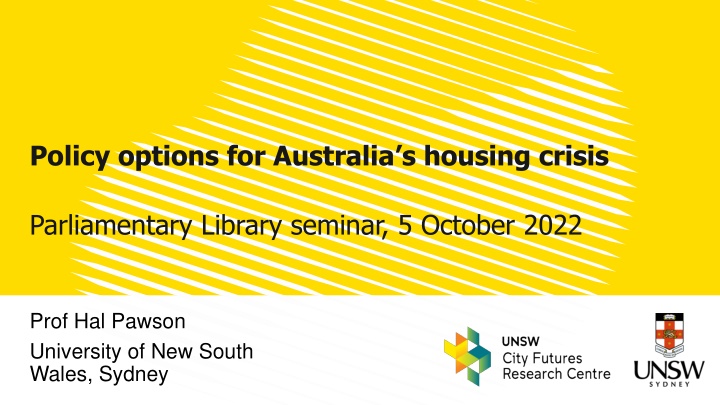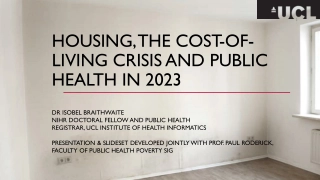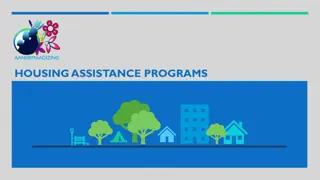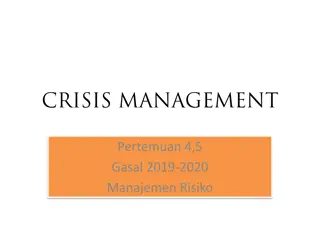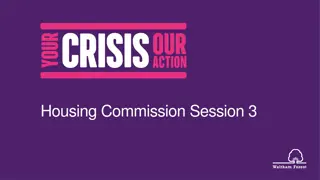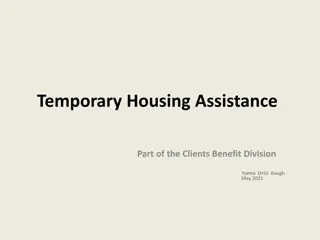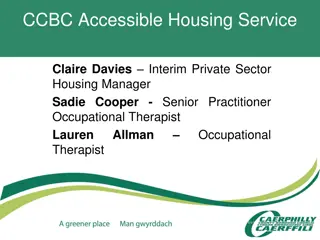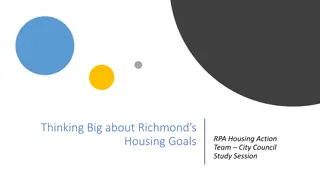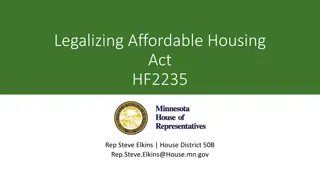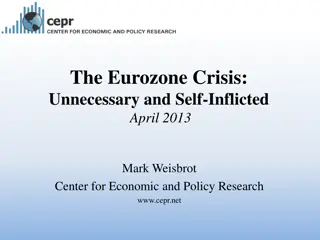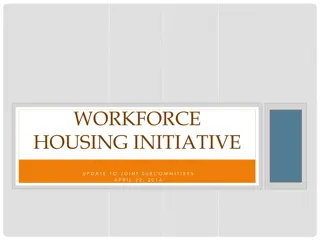Addressing Australia's Housing Crisis: Policy Options and Recommendations
Australia is facing a severe housing crisis, with housing unaffordability at the forefront of policy concerns. The presentation by Prof. Hal Pawson outlines key areas of focus, such as the financial thresholds for home ownership and rental affordability. The impact of over-expensive housing on individual welfare, economic productivity, and government spending is also discussed. Recommendations include the scope of the National Housing and Homelessness Plan, overarching objectives, and policy options to address the crisis.
Download Presentation

Please find below an Image/Link to download the presentation.
The content on the website is provided AS IS for your information and personal use only. It may not be sold, licensed, or shared on other websites without obtaining consent from the author.If you encounter any issues during the download, it is possible that the publisher has removed the file from their server.
You are allowed to download the files provided on this website for personal or commercial use, subject to the condition that they are used lawfully. All files are the property of their respective owners.
The content on the website is provided AS IS for your information and personal use only. It may not be sold, licensed, or shared on other websites without obtaining consent from the author.
E N D
Presentation Transcript
Policy options for Australias housing crisis Parliamentary Library seminar, 5 October 2022 Prof Hal Pawson University of New South Wales, Sydney
P Presentation outline 1. Crisis, what crisis? 2. What should be the scope of Federal Labor s National Housing and Homelessness Plan (NHHP)? 3. What overarching objectives should feature in NHHP? 4. How could a National Plan be progressed? 5. What kinds of policy recommendations would follow from proposed Plan objectives? [23 slides]
Housing unaffordability: why does it matter? Stressed affordability main contemporary focus of housing policy concern Over-expensive housing impacts on: 1. Individual welfare household financial stress 2. National economic productivity e.g: a) High housing costs crowd out consumer spending b) Excess capital/debt committed to unproductive asset 3. Cost to govt future age pension spend potentially inflated by falling HO for older age cohorts
Housing affordability: 2 distinct areas of focus 1. The financial threshold for home ownership house prices in relation to middle income earner buying power 2. Rental affordability for low-income earners how many people pushed into poverty by over-expensive rents Because housing is a system, 1 & 2 are linked: High house prices mean more young adults on middle to high incomes trapped for longer in rental housing Resulting demand pressure on rents impacts low-income tenants
House prices and home ownership affordability $'000s Chart shows gap between (a) median prices and (b) borrowing capacity of median earner Measures what a median earner could (theoretically) borrow, factoring in: Standard mortgage lender rules Prevailing interest rates Prices took off around 2000 since then large gap opened up between the two lines (much bigger for Syd/Melb) The extra amount a median earner would need to find on top of their max allowable loan to afford a typical house $700 Real median dwelling prices, $2021 $600 $500 $400 $300 Real borrowing capacity - earner on AWOTE, $2021 $200 $100 $0 1991 1985 1988 1994 1997 2000 2003 2006 2009 2012 2015 2018 2021 Source: Raw data underpinning Figures 3.2 and 3.5 in Housing Policy in Australia
Growing scale of deposit barrier Years of saving needed for standard deposit, houses and units, Syd/Melb Effect of rising prices on necessary size of mortgage offset by falling interest rates (until 2022) Increasingly, required deposit has become limiting factor Years of deposit saving needed in Sydney up from 8 years to 13.5 years 2008-2021 14.0 13.0 12.0 11.0 10.0 9.0 8.0 7.0 6.0 6/1/2005 6/1/2018 10/1/2009 11/1/2010 12/1/2011 7/1/2006 8/1/2007 9/1/2008 1/1/2013 2/1/2014 3/1/2015 4/1/2016 5/1/2017 7/1/2019 8/1/2020 Sydney Melbourne Sources: CoreLogic and ANU Centre for Social Research and Methods
House price affordability an unusually serious problem in Australia : where s the evidence? Increases in house price to income ratios, selected OECD countries, 1985- 2016 Source: Figure 3.1 in Housing Policy in Australia LUX House price affordability has declined faster in Aus than in most other OECD countries Price to Income Ratio up by 180% since 1985 in Aus one of the biggest increases in the OECD BEL AUS CAN NZ UK NTH FRA IRE SWE NOR ITA DEN FIN ESP US CHE % increase DEU 0 50 100 150 200 250
Home ownership unaffordability impacts Overall HO rate in Aus drifting down for 20 years Far from unique, internationally, but deeply embedded Much worse for young adults HO rate down from 60% to 40% since 1981 Latest reductions (2016-21) especially marked in middle income cohort Home ownership rates, Aus and selected comparator countries, 2003- 2019 110.0 105.0 100.0 95.0 90.0 85.0 Aus Ire Can Neth Fin Sing Ger UK Sources: OECD and others see Pawson et al. (2022)
Rental affordability a growing problem in Australia : where s the evidence? % Housing costs as % of income 35 Avg % of income spent on housing rising steadily for low income earners since mid-2000s Rents at low end of market rising ahead of incomes for low-paid workers; benefit recipients Supercharged rent inflation 2021-2022 now compounding the problem Rising homelessness continuing to run ahead of popn growth Indigenous Australians hugely over-represented among rentally stressed/homeless Lowest quintile 30 25 Average 20 Highest quintile 15 10 5 0 Source: Fig 3.7 in Housing Policy in Australia raw data, ABS
Growing deficit of private rental housing Growing deficit of private rental housing affordable to low income earners affordable to low income earners Source: Hulse et al. (2019) Figure A4. (Also Figure 3.12 in Housing Policy in Australia ) 20 Supply deficit (000 tenancies) 1996 2006 2011 2016 -20 Note: Graphed figures calibrate Australia-wide total of private rental tenancies affordable to quintile 1 households, minus number of quintile 1 households. -60 -48 -100 -140 -139 -180 -188 -220 -212
Strategy scope Important to avoid defining housing policy narrowly e.g. just about social housing and homelessness: In a complex system like the housing market different segments are connected Polices affecting one segment of the housing spectrum ripple through other segments (Productivity Commission 2022, p9) Housing strategy logically needs to encompass quality/condition (e.g. energy performance, rundown state of public housing)as well as access/affordability Housing policy powers importantly include: Regulation Taxation Expenditure Given Aus governance structure, national strategy might logically provide framework for state/territory-specific strategies and implementation plans
Possible overarching objectives for national housing plan (or strategy) 1. The market functions more smoothly; housing stock is utilised more efficiently 2. Housing system impairment of economic productivity and equity is reduced [connects into central govt priority] 3. The energy and environmental performance of the housing stock is enhanced [connects into central govt priority] 4. A more diverse range of housing forms enhances consumer choice 5. Historically rising levels of housing affordability stress and homelessness are reversed
Objective 1. The market functions more smoothly; housing stock is utilised more efficiently Australia s housing market notoriously volatile both socially and economically damaging E.g. Discourages investment in workforce capacity and technological development Making more efficient use of housing (and developable land) consensus objective in a world of constrained resources Speculative dynamics deeply damaging developable land and housing acquired/held for future anticipated gain, not current use Developer land-banking, grossly under-utilised owner occupied homes, inefficient utilisation of housing under AirBnB use
Objective4. A more diverse range of housing forms enhances consumer choice Aus housing system highly producer-dominated Consumer interests weakly represented Both new housing development and existing stock highly polarised: large suburban houses vs. small urban apartments Need to remedy missing middle : House type (insufficient town house type stock; larger apartments) Density (relative dearth of medium density) Provider type (PRS dominated by mum and dad landlords)
4. Developing a National Housing and Homelessness Plan: some practical considerations
Practical considerations (1) Plan-making responsibility and governance Assume led by Housing Australia as national housing agency; additional expert capacity commissioned as needed Oversight group could include external stakeholders; independent experts Initial task: define mission and overarching objectives (OOs) ideally owned by all state/territory govts possible role for summit event Supporting reviews, analyses (e.g. structured according to OOs) needed Framing/drafting must articulate with stated national policy/plans in other relevant policy areas incl: Climate change, NDIS, Aged care, Migration, Closing the Gap Must accommodate NHHA structure established framework enabling federal funding for state/territory housing/homelessness services
Practical considerations (2) Ideally aim to produce draft strategy (or even OOs) as main vehicle for wider consultation Implicit commitment to some expenditure growth possibly needed to secure necessary buy-in But substantial scope for redirection of resources, and emphasis on use of non-expenditure powers (e.g. tax, regulation) Associated guidance on state/territory housing strategies and scope for bottom up engagement essential
Overarching objective 1. More efficiency, less volatility Policy example(s) Phase in broad-based land tax to replace stamp duty Adjust tax and housing finance regulation to dis-incentivise mum-and-dad investor representation Move towards diversifying market structure by expanding role of govts, not-for-profits, build-to-rent developers Policy recs Adjust social security/tax policy settings to tackle over-expensive housing e.g. redress over-preferencing of private housing as asset class 2. Reduce housing system drag on economic performance 3. Improve dwelling quality (incl. energy performance) 4. Enhance housing system diversity and choice Incentivise energy conscious design and investment through stronger building code, mandatory energy performance disclosure Equalise structural tax disadvantages to boost build-to-rent housing Re-balance rights and obligations between private landlords and tenants Planning reforms to enable more medium density development Expand social housing (at least to OECD average) Also most of the above! 5. Reduce unaffordability and homelessness
Key supporting references Key supporting references City Futures Research Centre (2020) NSW Housing Strategy Discussion Paper: Submission to NSW Government Hulse, K. et al. (2019) The supply of affordable private rental housing in Australian cities: short- term and longer-term changes; Final Report 323; Melbourne: AHURI Maclennan, D., Long, J., Pawson, H., Randolph, B., Aminpour, F. and Leishman, C. (2021) Housing: Taming the Elephant in the Economy; Sydney: UNSW Milligan, V. and Pawson, H. (2021) A Housing Strategy for NSW: a good idea, but Housing 2041 falls short; Fifth Estate, 6 May 2021 Pawson, H., Milligan, V. & Yates, J. (2020) Housing Policy in Australia: A case for system reform; Singapore: Palgrave Pawson, H., Martin, C., Lawson, J., Whelan, S. and Aminpour, F. (2022) Assisting first homebuyers: an international policy review, Final Report No. 381, Melbourne: AHURI Productivity Commission (2022) In need of repair: The National Housing and Homelessness Agreement; Overview report; Canberra: Productivity Commission
